Birdfinding.info ⇒ The Floridian, Bahaman, and Cuban form of Burrowing Owl is uncommon, local, declining, and now almost entirely confined to the U.S. Traditional sites that have been occupied consistently in recent years include: several Broward County parks (including Brian Piccolo, Central Broward, Markham, and Vista View) west of Fort Lauderdale; Florida Atlantic University in Boca Raton; Cape Coral; Marco Island; Kissimmee Prairie Preserve State Park; and Watermelon Pond Wildlife and Environmental Area west of Gainesville. Outside of Florida it has vanished from most of its former range, but remains numerous on Great Inagua.
“Florida Burrowing Owl”
Athene cunicularia floridana
Endemic to Florida, the Bahamas, and Cuba. Endangered and declining across most of its range; possibly extirpated from Cuba.
In Florida, native to interior savannahs north and west of Lake Okeechobee, and scrubby habitats along the coasts from Cape Canaveral and Tampa Bay to the Keys. Modern development has eliminated much of its original habitat and replaced it to a large extent with alternative habitats that include golf courses, airports, pastures, campuses, and various other types of open land.
Current range in Florida extends patchily from the Gainesville area south to Homestead, plus two small outpost populations: one on Eglin Air Force Base in the western Panhandle; and the other around Marathon in the central Keys. A third outpost colony existed for many years in the Imeson Park district of Jacksonville, but disappeared in the early 1990s.
In the Bahamas, now mostly limited to Great Inagua, which supports a sizeable population. Until the 1980s or so, it was regarded as a fairly common, but localized resident across most of the archipelago, but away from Great Inagua it is now either a vagrant or possibly still a rare resident in some remote areas. There are recent indications that it may still breed on Bimini and Little San Salvador (between Eleuthera and Cat Island).
On Cuba, it has traditionally been regarded as a resident breeder in the western provinces and the far southeast (Guantánamo), but there are very few recent records, and no pattern to indicate that a breeding population remains anywhere on the island. However, it is conceivable—perhaps even likely—that isolated colonies persist undetected or unreported in areas that do not receive much ornithological attention.
Movements. Nonmigratory but dispersive. The “Florida Burrowing Owl” has been confirmed as a wanderer to Louisiana, Alabama, Georgia, and South Carolina, and on many Caribbean islands, including the Dry Tortugas, Cayo Coco, and generally across the Bahamas.
Identification
Generally similar to the widespread “Western Burrowing Owl,” but typically darker and more heavily marked. Approximately intermediate in size and coloration between “Western” and “Hispaniolan” forms.
It has a mostly brown chest with distinct white spots and dense barring on the belly. The upperparts are medium- to dark-brown with smallish, well-defined white spots. The crown is densely streaked.

“Florida Burrowing Owl,” A. c. floridana, showing typical medium-brown coloration and strong contrast on underparts. (Cape Coral, Florida; May 13, 2015.) © dllaliberte
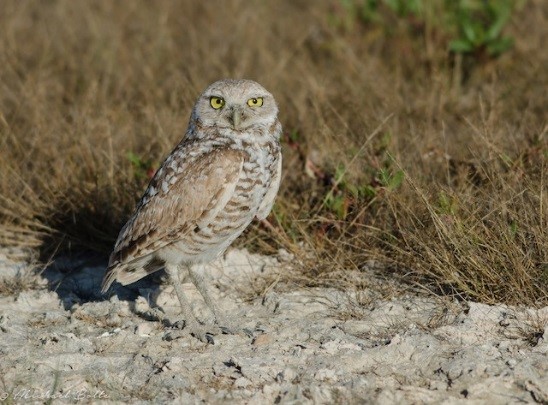
“Florida Burrowing Owl,” A. c. floridana, appearing much paler and less contrasty than most. (Inagua Outback Lodge, Great Inagua, Bahamas; March 23, 2018.) © Michael Bolte
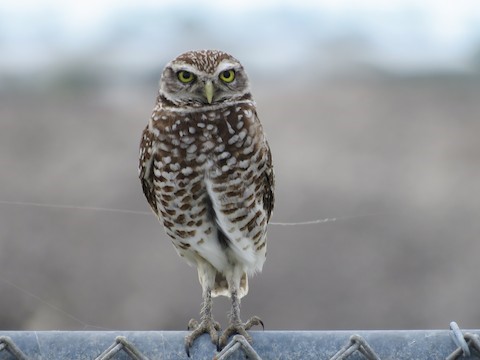
“Florida Burrowing Owl,” A. c. floridana, showing dark-brown coloration and strong contrast on underparts. (Homestead, Florida; April 17, 2019.) © Jeanne Kaufmann
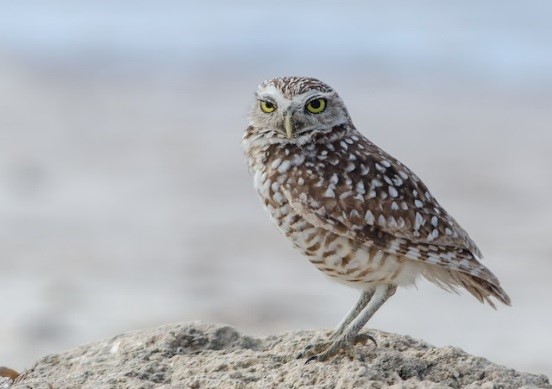
“Florida Burrowing Owl,” A. c. floridana, showing typical contrast above and below. (Inagua Outback Lodge, Great Inagua, Bahamas; March 23, 2018.) © Michael Bolte

“Florida Burrowing Owl,” A. c. floridana, a warm-brown, low-contrast individual. (Davie, Florida; March 28, 2019.) © Steven Glynn
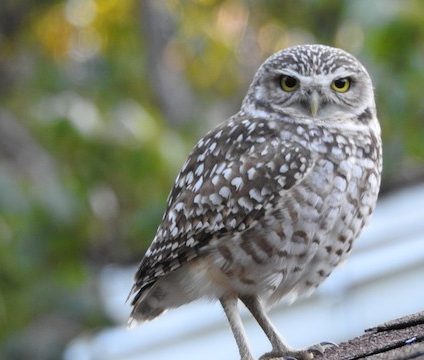
“Florida Burrowing Owl,” A. c. floridana, a pale individual showing weakly contrasting underparts. (Elbow Cay, Abaco, Bahamas; February 17, 2016.) © Milton Harris
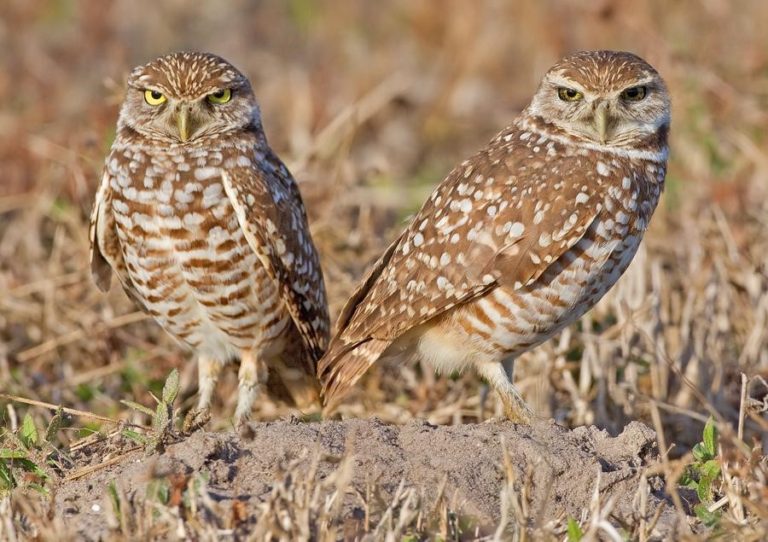
“Florida Burrowing Owl,” A. c. floridana, appearing sandy-brown, but otherwise typically marked. (Cape Coral, Florida; February 13, 2010.) © Paul Cools

“Florida Burrowing Owl,” A. c. floridana, showing typically strong markings. (South Bimini, Bahamas; October 29, 2018.) © Edward Massiah
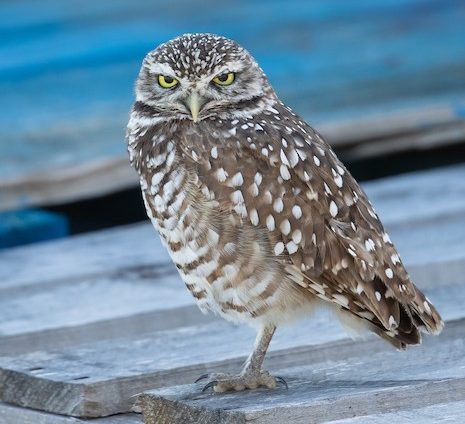
“Florida Burrowing Owl,” A. c. floridana, with somewhat washed-out underparts pattern. (Homestead, Florida; April 22, 2019.) © Caroline Lambert
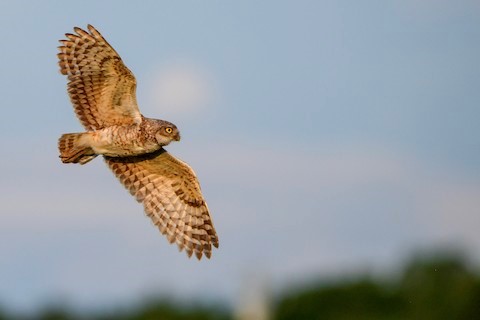
“Florida Burrowing Owl,” A. c. floridana, showing spckled underwing coverts. (Marion County Airport, Dunnellon, Florida; June 12, 2018.) © Dan Rieck
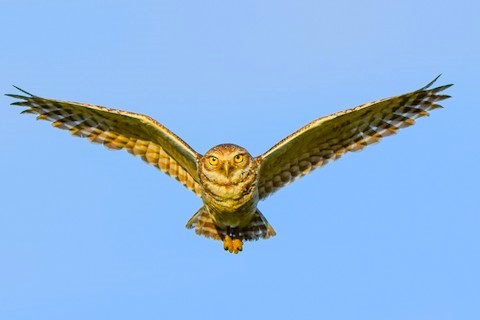
“Florida Burrowing Owl,” A. c. floridana. (Marion County Airport, Dunnellon, Florida; June 12, 2018.) © Dan Rieck
Cf. “Western Burrowing Owl”. The “Western” and “Florida” forms of Burrowing Owl usually do not overlap, but both are mobile. “Western” is migratory and a frequent vagrant to eastern North America—presumably including Florida, although such individuals would normally go unnoticed due to confusion with the local resident form. “Florida” is dispersive and has occurred north at least to Louisiana and South Carolina.
The “Florida” form is darker and about 10% smaller than “Western,” with more extensive brown markings on the underparts. In flight, the coloration of the wing linings is diagnostic: all-white on “Western” but speckled with brown on “Florida.”
Cf. “Hispaniolan Burrowing Owl”. The “Florida” and “Hispaniolan” forms of Burrowing Owl occur in fairly close proximity to one another, and a wanderer of either form would be difficult to distinguish from the other.
The Florida form averages paler and about 10% larger than “Hispaniolan,” and typically has sparser brown markings on the underparts—however, due to individual variation within each form, there is likely some overlap in these features. In flight, the coloration of the underwing coverts is diagnostic: lightly speckled with brown on “Florida” and more heavily mottled on “Hispaniolan.”
Notes
Monotypic form, one of twelve potentially distinct forms of Burrowing Owl.
References
Alderfer, J., and J.L. Dunn. 2014. National Geographic Complete Birds of North America (Second Edition). National Geographic Society, Washington, D.C.
eBird. 2019. eBird: An online database of bird distribution and abundance. Cornell Lab of Ornithology, Ithaca, N.Y. http://www.ebird.org. (Accessed October 23, 2019.)
Enríquez, P.L., K. Eisermann, H. Mikkola, and J.C. Motta-Junior. 2017. A Review of the Systematics of Neotropical Owls (Strigiformes), Neotropical Owls: Diversity and Conservation (P.L. Enríquez, ed.). Springer International Publishing, Cham, Switzerland.
Garrido, O.H, and A. Kirkconnell. 2000. Field Guide to the Birds of Cuba. Cornell University Press, Ithaca, N.Y.
Holt, D.W., R. Berkley, C. Deppe, P. Enríquez Rocha, J.L. Petersen, J.L. Rangel Salazar, K.P.. Segars, K.L. Wood, E. de Juana, and J.S. Marks. 2019. Burrowing Owl (Athene cunicularia). In Handbook of the Birds of the World Alive (J. del Hoyo, A. Elliott, J. Sargatal, D.A. Christie, and E. de Juana, eds.). Lynx Edicions, Barcelona. https://www.hbw.com/node/55091. (Accessed June 14, 2019.)
König, C., and F. Weick. 2008. Owls of the World (Second Edition). Yale University Press, New Haven.
Mikkola, H. 2012. Owls of the World: A Photographic Guide. Firefly Books, London.
Raffaele, H., J. Wiley, O. Garrido, A. Keith, and J. Raffaele. 1998. A Guide to the Birds of the West Indies. Princeton University Press, Princeton, N.J.
Sibley, D.A. 2000. The Sibley Guide to Birds. Alfred A. Knopf. New York.
Williams, R. 2019. Burrowing Owls Are the Family Next Door in this Florida Boom Town. Audubon.org. https://www.audubon.org/news/burrowing-owls-are-family-next-door-florida-boom-town.
